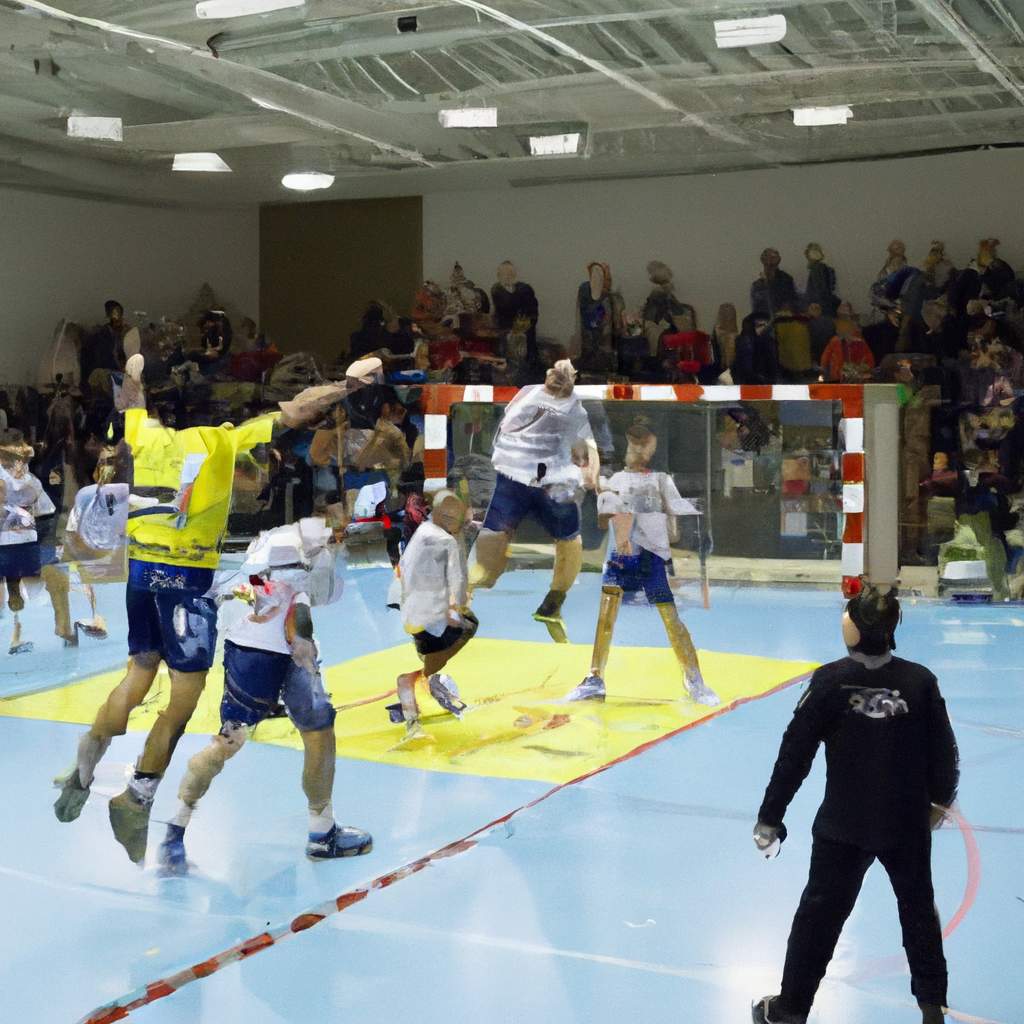Handball is a team sport played by 7 players against 7 on a field 40 meters long and 20 meters wide. The aim of the game is to score more goals than the opposing team by throwing the ball into the opposing team’s goal.
How does a handball match take place?
A handball match takes place on a rectangular field 40 meters long and 20 meters wide, divided into two halves by a center line. Each team is made up of 7 players, including a goalkeeper. The aim of the game is to score more goals than the opposing team by throwing the ball into the opposing team’s goal.
The match takes place in two halves of 30 minutes each, separated by a 10-minute break. The actual playing time is often less, because it is stopped each time a player commits a foul, a goal is scored or there is an interruption of play.
At the start of the match, the teams place themselves in their respective camps. The player of the team that won the draw chooses which side of the field to take the throw-in. The player who makes the commitment must therefore have at least one foot on the center line.
The game begins with a faceoff, which involves throwing the ball into the air in the center of the field. The two teams then compete to recover it and throw it into the opposing goal.
The game is fluid and fast. Players can dribble, pass the ball to a teammate or shoot on goal. Physical contact is permitted, but pushing, holding or hitting an opponent is prohibited.
Fouls are punished by free throws, seven-meter throws or temporary exclusions.
The match ends when regulation time has expired. If the two teams are tied, the match is extended by two periods of 5 minutes each. If the two teams are still tied at the end of extra time, the match is then decided by a penalty shootout.
Here are some additional rules of handball:
- A player can hold the ball for a maximum of 3 seconds.
- A player cannot dribble more than 3 times without passing the ball to a teammate.
- A player cannot cross the goal line with the ball.
- A player cannot touch the ball with his feet or legs.
Handball is an exciting and spectacular sport that is played all over the world.
How long is a senior handball match?
The normal duration of a senior handball match is 60 minutes, or 2 x 30 minutes. However, the actual playing time is often less, as it is stopped each time a player commits a foul, a goal is scored or there is an interruption of play.
In fact, the clock is stopped each time a referee calls a foul, a goal is scored or play is interrupted for any reason. This may include injuries, player changes or discussions between referees.
Therefore, the effective playing time of a senior handball match is generally between 45 and 55 minutes.
Here are some examples of situations that can cause the timer to stop:
- Faults: Faults are classified into different categories, and the most serious result in stopping the clock.
- Goals: the clock is stopped when the ball crosses the goal line.
- Interruptions of play: The clock is stopped for any interruption of play, whether due to injury, a change of player or a discussion between the referees.
How long does an under-13 and junior handball match last?
For teams under 13 and junior, the duration of a handball match is 2 x 25 minutes. The half-time break is 10 minutes.
This duration is reduced to allow young players to rest and rehydrate more often. It is also adapted to their level of physical and mental development.
Indeed, young players are less resistant than adults and need more frequent breaks. They are also less focused for long periods of time and need to stretch their legs more often.
The duration of an under-13 and junior handball match is as follows:
- Playing time: 2 x 25 minutes
- Half-time break: 10 minutes
- Actual playing time: approximately 45 minutes
How long does a women’s handball match last?
The duration of a women’s handball match is the same as that of a men’s handball match, i.e. 60 minutes.
There is no difference in length between men’s and women’s matches, whether at the amateur or professional level.
The duration of a women’s handball match is as follows:
- Playing time: 2 x 30 minutes
- Half-time break: 10 minutes
- Actual playing time: approximately 45 minutes
How long does a professional handball match last?
Professional handball matches are generally longer than amateur matches, as they are often followed by player interviews and award ceremonies.
The duration of a professional handball match can therefore vary between 70 and 90 minutes.
The difference in duration between amateur and professional matches can be explained by several factors:
- Player interviews and award ceremonies: These events usually take around 15 minutes and are usually held after the match.
- Referee interviews: Referees are often interviewed after the match to comment on the decisions they made. These interviews can last around 10 minutes.
- Leaders’ speeches: Club or federation leaders may also speak after the match to make statements. These speeches can last around 5 minutes.
In conclusion, professional handball matches are generally longer than amateur matches, as they are often followed by player interviews, award ceremonies and speeches by managers.
Here is an example of the duration of a handball match professional :
- Playing time: 2 x 30 minutes = 60 minutes
- Player interviews and awards ceremonies: 15 minutes
- Referee interviews: 10 minutes
- Speech by leaders: 5 minutes
Total duration: 70 minutes
How long does a handball half last?
Halftime of a handball match lasts 10 minutes. This duration is the same for all handball matches, whether amateur or professional.
Halftime is a break that allows players to rest and rehydrate. It is also an opportunity for coaches to give instructions to their players.
The half-time of a handball match is divided into two parts:
- The first part lasts 5 minutes and is devoted to the players’ rest.
- The second part lasts 5 minutes and is devoted to the coaches’ instructions.
Here is an example of how a handball half plays:
- The players from both teams retire to their respective benches.
- The players rest and hydrate.
- The coaches of the two teams meet to give instructions.
- The players are preparing for the second half.
Total time: 10 minutes
How many timeouts are there in a handball match?
Each team has three timeouts per match, to be used within the limit of two per half. A dead time lasts one minute.
Downtime can be requested by the coach of the team in possession of the ball. The time-out is granted by the referees as soon as the coach presents his green card to the timekeeper.
Downtime is used to give instructions to the players. They can also be used to treating an injured player.
Timeouts are an opportunity for coaches to reorganize their team and give tactical instructions. They can also be used to motivate players or to provide them with psychological support.
In the final minutes of the match, timeouts can be used to stop the game and take time to think about a winning strategy.
Here are some examples of situations in which a coach may call a time out:
- When the team is in difficulty and needs to re-mobilize.
- When the team is losing and they need to find a solution.
- When the team is winning and wants to consolidate its lead.
- When the team wants to change strategy.
- When the team must treat an injured player.
Timeouts are an important tool in handball. They can be used to influence the course of the match and to give teams a chance to come back.
What are the basic rules of handball?
The basic rules of handball are as follows:
- The aim of the game is to score more goals than the opposing team by throwing the ball into the opposing team’s goal.
- The match takes place on a rectangular field 40 meters long and 20 meters wide, divided into two halves by a center line.
- Each team is made up of 7 players, including a goalkeeper.
- Players can dribble, pass the ball to a teammate or shoot on goal.
- Physical contact is permitted, but pushing, holding or hitting an opponent is prohibited.
- Fouls are punished by free throws, seven-meter throws or temporary exclusions.
Here are some additional rules of handball:
- A player can hold the ball for a maximum of 3 seconds.
- A player cannot dribble more than 3 times without passing the ball to a teammate.
- A player cannot cross the goal line with the ball.
- A player cannot touch the ball with his feet or legs.
The goalkeeper has special rules:
- The goalkeeper can touch the ball with any part of his body, including his feet and legs.
- The goalkeeper cannot come out of his penalty area to intercept the ball.
Free throws are awarded when the opposing team commits a foul. The player making the free throw must stand 9 meters from the opposing goal.
Seven-meter throws are awarded when the opposing team commits a serious foul in the penalty area. The player who executes the seven-meter throw must stand 7 meters from the opposing goal.
Temporary exclusions are granted when the opposing team commits a serious offense. The excluded player must leave the field for 2 minutes.

